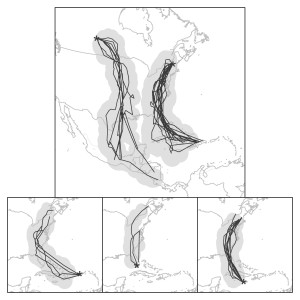
Figure 4. The most probable spring migration routes (lines) and 95% confidence intervals (shaded area) of Ovenbirds (n = 43) captured at five locations across a broad geographic distribution determined using ‘noon’ locations obtained with archival light-level geolocators. Capture locations are illustrated with dots. Fall migration was not considered because the Ovenbird migration overlaps with the fall equinox when latitudinal location estimates are not reliable.
New paper incorporates archival light-level geolocators and band recoveries to estimate Migratory Connectivity of a Neotropical migratory songbird. “We found a complete separation of eastern and western populations of Ovenbirds throughout the annual cycle. Breeding Ovenbirds from western Canada spent the non-breeding season throughout Central America and migrated through central North America during spring migration. Birds breeding in northeastern United States were distributed throughout the central Greater Antilles in the Caribbean and migrated through eastern North America during spring migration.”

